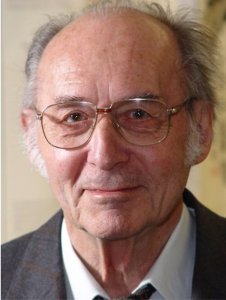Hans Berckhemer (1926 - 2014)
 Professor Dr. Hans Berckhemer died on 21 July 2014 after a short illness. He was worldwide recognized as an outstanding geophysicist and seismologist. Hans Berckhemer had been Chairman of the German National IUGG Committee and the National Representative for IUGG (1971-75), Vice President of IASPEI (1971-75), Chairman of the International Geodynamics Project Working Group 3 (Alpine-Mediterranean Region) (1973-79), President of IASPEI (1975-1979), and President of the German Geophysical Society (DGG, 1979-81). He was a DGG honourable member, an elected member of the Deutsche Akademie der Naturforscher Leopoldina (German National Academy of Sciences) and was honored with the Otto Yuljevich Schmidt Medal of the United Institute of Earth Physics named for O.Yi.Schmidt of the Russian Academy of Sciences.With him, IUGG, IASPEI and the German geophysicists lose a highly respected member, a scientist and teacher who nationally and internationally influenced for many decades research in seismology, experimental rock physics and deep seismic sounding.
Professor Dr. Hans Berckhemer died on 21 July 2014 after a short illness. He was worldwide recognized as an outstanding geophysicist and seismologist. Hans Berckhemer had been Chairman of the German National IUGG Committee and the National Representative for IUGG (1971-75), Vice President of IASPEI (1971-75), Chairman of the International Geodynamics Project Working Group 3 (Alpine-Mediterranean Region) (1973-79), President of IASPEI (1975-1979), and President of the German Geophysical Society (DGG, 1979-81). He was a DGG honourable member, an elected member of the Deutsche Akademie der Naturforscher Leopoldina (German National Academy of Sciences) and was honored with the Otto Yuljevich Schmidt Medal of the United Institute of Earth Physics named for O.Yi.Schmidt of the Russian Academy of Sciences.With him, IUGG, IASPEI and the German geophysicists lose a highly respected member, a scientist and teacher who nationally and internationally influenced for many decades research in seismology, experimental rock physics and deep seismic sounding.
Hans Berckhemer was born 16 January 1926 in Stuttgart, Germany, where he also grew up and received his academic education at the University of Stuttgart. In 1951, he received the Diploma in Physics and in 1954, he finished his studies with the PhD (Dr. rer. nat.). During this time, he already worked as Research Associate at the Geophysical State Institute in Stuttgart (1951-1963) and focused his interests on seismology. After his PhD, Hans Berckhemer spent about a year in USA as a Fulbright Research Fellow at the Lamont Geological Observatory, Columbia University, New York, where he co-operated among others with Maurice Ewing, Jack Oliver and Frank Press. During this time, he worked on surface wave propagation, sediment cores from the deep Atlantic, and made laboratory experiments to study seismic wave propagation phenomena. Hans Berckhemer participated in one of the early cruises of the Lamont research vessel RV VEMA in the Atlantic and he often told us that data measured during the RV VEMA cruise later led to the discovery of the well-known stripes of positive and negative magnetic anomalies of the oceanic crust. During his time in the USA, he also visited for a short time the Seismological Laboratory of CALTECH in Pasadena to work with Beno Gutenberg. After his time in the USA, Hans Berckhemer returned to Stuttgart and continued there his work, but in 1960 he went again on travel and spent some time as Invited Scientist at the University of Tehran, Iran. From 1958 on, Hans Berckhemer started his connection with the Institute for Meteorology and Geophysics of the Johann Wolfgang Goethe University in Frankfurt am Main, Germany. First, he gave lessons in Geophysics as an external lecturer coming from Stuttgart, later, in 1961, he received his Habilitation (venia legendi) for Geophysics from the University of Frankfurt (as Beno Gutenberg had 39 years earlier), and became in 1963 full Professor for Geophysics. Hans Berckhemer held this position for the next 31 years, when he became a Professor emeritus.
During his more than 50 year long career as seismologist and geophysicist, Hans Berckhemer worked on a great variety of topics, such as dynamic processes in the earthquake focus, seismometry (especially broadband seismology), laboratory experiments on seismic wave propagation, deep seismic sounding profiles, and experimental rock physics (high temperature anelasticity, fracture processes).
At the beginning of his career, Hans Berckhemer worked on surface wave propagation, developed seismometers for seismic stations and temporary field deployments and contributed to the development of an analog data logger, which were widely used for many national and international seismic reflection and refraction experiments from the late 1960s to the early 1980s. He was the principle investigator in refraction experiments investigating the crustal structure in the Alps (Ivrea body) and in Africa (Afar Depression, Ethiopia and Damara Orogen, Namibia). In the early 1960s, in a time when computer based calculation of theoretical seismograms was still impossible, Hans Berckhemer conducted seismic experiments in the laboratory to physically simulate elementary wave propagation processes, such as reflection, refraction and head waves, with thin plates of aluminum and acrylic glass. Later, he worked on problems of double couple radiation, energy radiation from propagating faults and seismic source dynamics.
From 1970 on, Hans Berckhemer was one of the first seismologists who promoted the advantages of digital broadband recordings and was one of the key persons behind the decision to build the first broadband array worldwide, the Gräfenberg Array, in Germany. The Gräfenberg Array, with its high quality digital broadband recordings, became a huge success and prepared the way for the breakthrough of modern broadband seismology. Consequently, Hans Berckhemer was at the end of the 1980s also one of the driving forces to install the German Regional Seismic Network (GRSN) of broadband stations.
In the 1970s and 1980s, the main research focus of Hans Berckhemer slowly changed to rock physics. He built up a high temperature, high pressure laboratory in Frankfurt to investigate rock material from the crust and the mantle. Topics under investigation were seismic wave velocities, their anisotropy, scattering and attenuation, and the processes for the formation of micro-cracks. One of the largest specimens of Moon rock from the APOLLO 16 mission, as well as hundreds of rock samples from the German deep drill experiment (KTB Windischeschenbach) were investigated in the Institute in Frankfurt.
Even after receiving the emeritus status, Hans Berckhemer continued to participate in seminars and colloquium talks at the Institute and continued his personal scientific work by e.g., investigating a 1 million year old meteorite crater in Ghana (Bosumtwi Lake). In 2006, Hans Berckhemer could celebrate his 80s birthday with a special colloquium and reception at the Institute. Only the last years, and in particular after the death of his wife in 2010, he retired more from science and was living the more silent life of a pensioner.
Like many other geophysicists, Hans Berckhemer liked to travel. During his long career, he visited, often accompanied by his wife, seismic observatories and scientific institutions and participated in workshops and conferences in numerous countries. By this, he became acquainted with many colleagues, many of whom visited him in return in Frankfurt. Often, these visitors were asked by Hans Berckhemer to give special lectures on their research topics, which enriched and broadened our education. Hans Berckhemer was a widely acknowledged academic teacher, who influenced generations of students in Frankfurt and supervised numerous Diploma and PhD-theses. He was always interested in the physical answer behind the question under investigation and gave many practical hints based on his long experience with physical experiments. Beside all his scientific interests, he will be remembered by his students as a friendly and sociable person, with humor, who helped insightfully when some of them struggled with their advancement. Many of his students became researchers and professors, several of them having already retired.
I met Hans Berckhemer for the first time, when I came to Frankfurt to study geophysics in the 1970s. During the following years, he was besides the late Gerhard Müller the academic teacher from whom I learned most in seismology and geophysics. The last time we met was at the end of September 2013, when he participated in the 100-year celebrations of the seismic station (Taunus Observatory) of the University of Frankfurt. He enjoyed speaking about the old times, when he visited Gutenberg in Pasadena and when he came to Frankfurt and renovated the seismic station about 50 years ago. I will remember Hans Berckhemer as an always interested discussion partner for my research topics and an engaged supporter of my personal interests in the history of seismology.
Johannes Schweitzer
Selected Bibliography of Prof. Hans Berckhemer
- Berckhemer, H. and J. Ansorge (1963). Wave front investigations in model seismology. Geophys. Prospecting 11, 459-470.
- Berckhemer, H. (1969). Direct evidence for the composition of the lower crust and the Moho. Tectonophys. 8, 97-105.
- Berckhemer, H. (1971). The concept of wide band seismometry. Proc. XII Ass. General CSE 1970, Luxembourg, 214-220.
- Berckhemer, H., B. Baier, H. Bartelsen, A. Behle, H. Burkhardt, H. Gebrande, J. Makris, H. Menzel, H. Miller and R. Vees (1976). Deep seismic sounding in the Afar Region and the highland of Ethiopia. In: "Afar Depression of Ethiopia", A. Pilger and A. Rösler (Editors), Schweizerbart, Stuttgart, 89-107.
- Berckhemer, H. and K. Hsü, Editors (1982). "Alpine Mediterranean Backarc Basins", AGU- Monographs, Geodynamics Series 7, 216 pp.
- Ulug, A. and H. Berckhemer (1984). Frequency dependence of Q for seismic waves in the Earth's mantle, J. Geophys. 56, 9-19.
- Berckhemer, H., A. Rauen, H. Winter, J. Zinke and H. C. Soffel (1997). Petrophysical properties of the 9 km deep crustal section at KTB. J. Geophys. Res. 102, 18337-18361.
